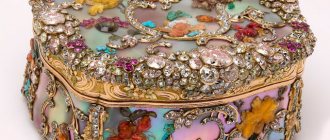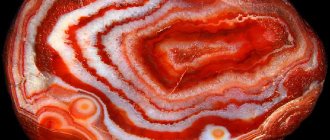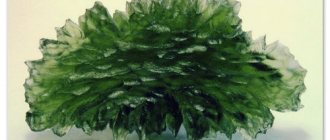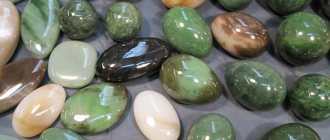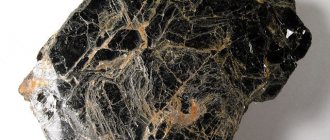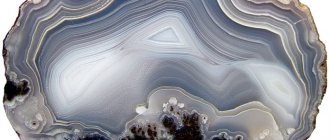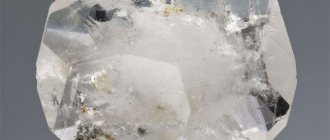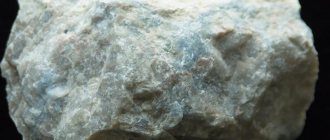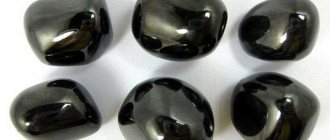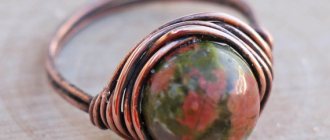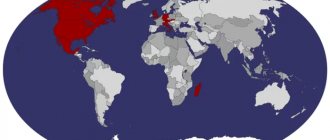| Category | Phosphates (minerals) |
| Title in English | Turquoise |
| Formula | CuAl6(PO4)4(OH)8 4H2O |
| Group | Turquoise group |
| Color | Blue, Green, Gray |
| Stroke color | Blue |
| Shine | Glass, Frosted |
| Transparency | Opaque, Transparent, Translucent |
| singonia | Triclinic |
| Hardness | 5 — 6 |
| Cleavage | Perfect/imperfect |
| Density, g/cm³ | 2,6 — 2,8 |
| Kink | Conchoidal |
| origin of name | The name of the oldest mineral, turquoise, comes from the Persian word firuze, which translates as “stone of happiness.” Also, there is a variant in which they use piruz, which means “the one who wins.” According to another version, the word turquoise was formed from the French Turquie - translated as “Turkish”. This is due to the fact that the first turquoise came to Europe through Turkey. By the way, because of this, turquoise is often called “Turkish”. |
| Morphology | Turquoise has rare crystals of a short plasmatic appearance with characteristic large facets. |
Turquoise is a gem of extraordinary beauty and properties. Even its main color is so incomparable that it was called turquoise. It is interesting that man has encountered this mineral throughout his history. All ancient peoples used turquoise in one way or another. And today the stone remains extremely popular, convenient for making jewelry and inexpensive. Over the thousand-year history of use, most deposits of turquoise have not been depleted and it is still being mined all over the globe. What can we say about the various magical and healing properties of the gem. In the world of precious stones, turquoise is a real miracle.
Turquoise deposits
Turquoise is a popular and valuable gem with numerous deposits.
However, its deposits are usually small, and therefore production becomes quite expensive. — Advertising —
Turquoise deposits in the Sinai Peninsula began to be mined around 6000 BC. e. By now, all of them have been almost completely depleted and are not suitable for industrial work, but locals continue to extract stone by hand.
Most of our natural turquoise today comes from large copper deposits as a by-product. This is done in the USA, as well as in Egypt, Iran, Afghanistan, Armenia, Tajikistan, Uzbekistan, Turkmenistan, Tanzania, Australia, and Argentina.
Turquoise and its “brothers” and “sisters”
Turquoise and similar minerals. Artificial and synthetic turquoise, imitations and fakes
We find stories and legends about turquoise in Al-Biruni, A.E. Fersman, M.E. Masson, K. Zeitner (Zeitner C, 1975), etc. Beautiful products made from turquoise by the most ancient masters of Egypt, North America and China are known throughout the world. In Rus', clothes, weapons, and religious objects were decorated with turquoise, and it was widely used in art and jewelry; To this day, turquoise has retained the purity and brightness of color among the often already faded pearls and amethyst. In many ancient burials opened in Central Asia, jewelry with turquoise was found. Turquoise is certainly present in the tombs of Egyptian pharaohs. The ancient Indian tribes of North America considered turquoise a magical stone and used it in religious rituals. The Persians deeply revered this stone, believing that it brought happiness and protected from evil. In Tibet, turquoise was considered not a stone, but a living creature, a deity. In the treasuries of the pharaohs or crowned heads of Europe - everywhere this precious stone occupied a worthy place. It is the official state stone of Arizona and New Mexico and may become the state stone of Nevada. Currently, it is known throughout the world not only as the stone of Iran. It is unknown whether turquoise will be as popular in the future, but it occupied a place in the history of civilization that no other precious stone has achieved. K. Zeitner writes: “Fashion for precious stones came and went, mythology and legends about stones changed over time and distance, but turquoise has always been considered a stone of health, happiness and good luck (Zeitner C, 1975).
A.E. Fersman (1925) classified turquoise as class 3 precious stones, A.I. Tsyurupa and some other researchers consider turquoise to be a semi-precious stone, and in the classification of E.Ya. Kievlenko et al. (1974) placed it in the 4th class of precious stones. This is explained by the fact that the quality and properties of the stone are not always the same, and therefore its cost is different. Meanwhile, turquoise can be very diverse both in its appearance and in its physical and chemical properties. properties. That is why turquoise is distinguished as precious, semi-precious, suitable for refining, and collectible. These varieties, or categories, of raw materials are available in all deposits, are found and mined together, and constitute common reserves that determine the industrial value of a particular object.
Researchers and jewelers are often surprised by the fact that individual samples and products made of turquoise in ancient burials or in the dumps of ancient workings retain their pristine properties for thousands of years, are not subject to any changes, and some cabochons are literally visible (for several months or several years) fade or turn from blue to green. As a rule, we can say that the turquoise that changes in modern products was captured by the process of decomposition, which cannot always be determined by eye. Often, under a microscope, in beautiful blue specimens of recently mined turquoise, a network of microcracks and thin films of hydroxides, microinclusions of jarosite, pyrite, and clay minerals penetrating the stone from the inside are discovered. Dense, brightly colored turquoise samples with a chemical composition close to the theoretical one have a massive, homogeneous macrostructure. In all other cases, turquoise in thin sections is characterized by unevenness and variety of structure. The initial stage of decomposition is associated with the appearance of a network of microcracks, forming false kidney-shaped forms and the structure of polygonal soils. On the same thin section in turquoise, one can observe variously shaped areas of micro- and cryptocrystalline, radial-radiant and spherulitic structures, both with gradual mutual transitions and with rather sharp restrictions. It is obvious that the spherulitic structure of turquoise noted by a number of authors is due to the development of planite, chalcedony and chrysocolla in it; the feathery and foliated structures belong to wavellite, alunite and clay minerals. The development of fine natural mixtures, the presence of numerous minerals similar to turquoise, the abundance of counterfeits of turquoise - all this makes it difficult to diagnose the stone. The following is also a brief description of minerals with physical properties close to turquoise and used, along with turquoise, in the jewelry industry.
Chalcosiderite is an iron analogue of turquoise, colored in light yellow-green tones. Triclinic syngony. Optically negative mineral. Hardness 4.5. Density 3.1. Forms clusters of sheaf-shaped crystals and crusts.
Aluminum-chalcosiderite is a mineral intermediate between chalcosiderite and turquoise. The color is deep green, grassy to bluish green. The fracture is uneven to conchoidal. Hardness 4.5. Density 3. Forms small spherical aggregates and nodules, small cryptocrystalline-fine-grained nodules and crusts.
Rashleichite (Rashleite) is also an intermediate mineral in composition between turquoise and chalcosiderite. Rich in iron (up to 20%), the color is dominated by green tones. Macroscopically indistinguishable from green varieties of turquoise.
Phostite (faustite) is a zinc analogue of turquoise with an apple-green color. Faustite forms veins and nodules. The fracture is smooth and slightly conchoidal. Fragile. Density 2.92. Hardness 5.5. The structure is micrograined, the refractive index is 1.61. The X-ray patterns of turquoise and faustite are close.
Nardite is a hydrous aluminum phosphate, a rare mineral somewhat similar to turquoise. It occurs in the form of bluish-green nodules in the voids of variscite nodules in pcs. Utah (USA), noted by T.I. Menchinskaya also at the Kalmakyr deposit in turquoise-bearing metasomatites. Hardness 5. Density 2.81. Refractive index 1.590-1599.
Variscite Photos
Variscite is aqueous aluminum phosphate Al(PO4) x 2H2O. Usually contains some amount of iron, its physical properties are similar to turquoise. Copper is not part of the mineral. The color is green, dark green, blue and yellow. Glass shine. Forms crusts, nodules, and rarely octahedral crystals. Hardness 4-5. Density 2.4-2.5. There is no cleavage. Refractive index up to 1.57. Variscite was found in Saxony, in an area previously called Variscia, which gave the name to the mineral. A mineral found in Australia with the properties of variscite was called “Australian turquoise” or “Australian jade”. The most common varieties of variscite develop in the form of eyes, which is not typical for turquoise. Variscite is a precious stone of America, where it is highly valued. High quality variscite is as rare as good turquoise, if not rarer.
Photo processed lazulite
Lazulite - mentioned by R. Webster among the minerals similar to turquoise. The mineral is similar in chemical composition to turquoise; it is a hydrous aluminum phosphate and contains impurities of iron and magnesium. Forms an isomorphic series from light blue lazulite to dark scorzalite. Hardness 5.5. Density 3.1., which is different from turquoise. Refractive index 1.b1-1.64. The mineral is sometimes called "bluespar". Unlike cryptocrystalline turquoise, it is represented by a fine-grained aggregate. Known in Switzerland, Brazil, in the USA (in the states of New Mexico and California). There are small deposits of lazulite in Canada.
Photo Chrysocolla
Photo of chrysocolla
Photo Chrysocolla
Chrysocolla is a mineral that is often mistaken for turquoise. It is a hydrous copper silicate of variable composition and with variable constants. The color is blue, cyan and bluish-green. Hardness 2-4. Density 2-2.4. Refractive index 1.50. Widely developed in the oxidation zone of polymetal and copper deposits, it forms crusts and thin veins, characteristic uneven kidney-shaped-lumpy collomorphic spherulite-like formations, in some cases it develops pseudomorphically in turquoise.
Odontolite - looks very similar to turquoise, it is often called “bone turquoise”, “turquoise tooth”, “western turquoise”. Substantiating the hypergene genesis of turquoise, some authors (Dana E.S., 1937) refer to odontolite, believing that these are animal bones and teeth impregnated with turquoise. Odontolite is not a mineral proper and is actually the bones of extinct animals, but impregnated not with turquoise, but with hydrous iron phosphate vivianite, sometimes called “blue earth” or “blue iron earth.” Some odontolites are impregnated with copper minerals, and then their color is green. The refractive index of odontolite is 1.57-1.63, hardness 5, density above 3. Boils from hydrochloric acid. Its primary organic structure is visible in thin sections.
Photo Stellarite
Stellarite is a natural mineral mixture, a unique combination of azurite, copper silicates, turquoise, malachite, chalcocite, native silver and iron sulfides (Webster R, 1975). Found in the southwestern part of the USA, it has an original color (two shades of blue on a black and silver background), is highly polished and can be successfully used in jewelry.
Imitations and fakes of turquoise Back in 1546 Agricola wrote: “No other stone can be imitated so indistinguishably as turquoise...” Imitations made by various methods make up about 80% of the modern turquoise market. Turquoise is often counterfeited with plastic - the cheapest non-porous imitation, which melts when heated and smells bad. Fakes made by surface painting of special ceramics, porcelain or bone are common. Such fakes can be recognized by splitting the stone and making sure that the false “turquoise” is white inside; There is also a specific sound when tapping on a stone. Less common are imitations made of glass or painted chalcedony, fired gypsum and alabaster. “Viennese turquoise” is a heat-treated and compressed mixture of malachite with aluminum hydroxide and phosphoric acid. Under the name “neolithic”, since 1957, a turquoise-like mixture of copper phosphate and aluminum hydroxide (bayerite) has been proposed - a by-product of aluminum production, similar in composition to hydrargillite. Most fakes have a bright and uniform greenish-yellow or aniline blue-green color, which is not typical for natural turquoise. When heated, they usually blacken or fuse into a black glassy mass, rather than cracking like turquoise. Restored or refined turquoise is the name given to stones (jewelry raw materials) obtained from porous, friable, calcareous low-quality turquoise by “refinement” by impregnation with resins, sodium silicate, and paraffin. Thus, the color and density of a significant part of porous turquoise from Arizona and Nevada (USA) is either restored by waxing or/and improved by cementation with plastic (alkyd resin).
Currently, synthetic turquoise, which is quite close in composition to natural turquoise, has become widespread.
Imitation, ennoblement, synthesis
The abundance of turquoise counterfeits is explained by the fact that turquoise has always been in great demand, as well as the scarcity of natural raw materials. Jewelry varieties of turquoise make up no more than 5-10% in each deposit, and in the total amount of turquoise sold on the world market, more than 80% of turquoise is refined, dyed, compacted and synthetic. In addition to the above minerals, which are similar in physical properties to turquoise, according to R. Webster (.Websteg R., 1975), the following turquoise-like materials enter the market:
Photo of colored howlite (turquenite)
Howlite (howlite, goulite) aka silicoborocalcite , aka caulite , aka turquenite. White or grayish-white in color, with brown or black veins similar to those of turquoise. It occurs in the form of porcelain-like aggregates and dense nodules. Sometimes it forms significant accumulations (California, USA and Nova Scotia, Canada). Easily lends itself to artificial coloring and is widely used painted in blue and blue-green tones in the form of imitation turquoise. Lighter and softer than turquoise. The color of skillfully painted material can be very bright, and its price is much lower. Howlite is sometimes also painted red to imitate expensive corals. Imitations of turquoise made from howlite are so turquoise-like that one should purchase items made from more expensive and rare turquoise with great caution, and only in cases where there is no doubt about possible falsification.
Cacholong Photos
Cacholong is a porcelain-like opaque mixture of fine-grained chalcedony and white opal. Other names: beautiful stone, Kalmyk agate, pearl agate, petrified milk of a sacred cow. Hardness 6.5-7.0 on the Mohs scale, density 2.1 g/cm3. Gloss - pearl, glass
Magnesite is a mineral named after the region of Magnasia, which is located in Greece. Magnesite is magnesium carbonate. The color of minerals can be white, gray, yellowish, or brown. Gloss - matte, glassy. Hardness - 4.0-4.5; density - 2.9-3.0 g/cm3. Main deposits: Russia, Austria, Greece, Mexico, China, India, USA, etc.
Dyed quartz is a material that is significantly less expensive than turquoise and is offered by American gemstone suppliers. In addition, there is an imitation of turquoise, represented by chalcedony, painted in the appropriate color. These stones are more transparent than turquoise. Their density is 2.63. Refractive index 1.53.
Glass and enamel were first used by the Egyptians 5 thousand years BC. e. to obtain a material similar to turquoise. It was a sinter of silica, calcium carbonate, soda and some copper components. Blue glass beads were found in the tomb of Tutankhamun (1350 BC), they were colored with cobalt. Modern glass beads are also made to look like turquoise, and sometimes they are passed off as turquoise. Most glass imitations have a higher density compared to turquoise. Enamels that imitate turquoise are slightly discolored silicate glass mixed with a mixture of metal oxides.
Plastic is the cheapest imitation of turquoise, but also the most easily distinguishable from it. Cabochons are cast from it, sometimes with a characteristic spider web pattern. But the coloring of plastic products is too deliberately perfect. They are lighter, softer, non-porous and without a waxy sheen. They melt on fire. “Vienna turquoise” is a mixture of a thin mass of malachite with aluminum hydroxide and phosphoric acid. After heating to more than 100°C, this mixture is compacted under pressure. The chemical composition and formula of this material differs from turquoise. The hardness of pressed “Viennese turquoise” is about 5, the density is 2.4, and when saturated with water it increases to 2.6. Refractive index 1.45. When heated, this fake blackens or fuses into black glass, rather than cracking like turquoise. “Synthetic turquoise” (“Neolithic”) - common since 1957. The stone is a pleasant blue color, sometimes with sinuous “groundmass” veins. It is a mixture of bayerite and copper phosphate, and the bulk is an amorphous iron compound. Bayerite is a by-product of aluminum production, similar in composition to the mineral hydrargillite. Hardness about 4, refractive index 1.55, density 2.4. Almost Neolithic is identical to Viennese turquoise. In 1953, artificial turquoise was created in America, consisting of small grains of blue and white material cemented with alkyd resin. The hardness of this “turquoise” is about 2.5, density 1.85. In some samples the hardness reaches 3.5 and the density 2.39. • Restored or enhanced turquoise is low-quality turquoise whose properties have been improved or restored by the addition of resins, sodium silicate, oil or paraffin. When well processed, this turquoise is visually indistinguishable from high-grade natural specimens and is often sold at the same price, sometimes slightly cheaper. Such turquoise should not be mixed with “restored” turquoise, made from a mixture of powder, ivory, copper dye and cement. The density of refined (waxed) chalk-like turquoise increases from 1.8 to 2.45, the hardness changes from 2 to 5. The refractive index reaches 1.61, i.e. the physical properties of refined turquoise are close to natural samples, as well as the chemical composition and structure of the main component of the stone. At the same time, the decorative effect of the stone improves dramatically. The color of a significant part of porous turquoise from the states of Arizona and Nevada (USA) was restored by waxing. The quality of impregnated wax is porous. American turquoise is improved by additional cementation with some kind of plastic. Typically, an alkyd resin is used for this purpose, with the help of which the calcareous turquoise from pieces is strengthened. Arizona. The hardness of these samples is about 3. Recently, calcareous turquoise has begun to be cemented with a silica hydrosol, the density of which is 1.21. Turquoise cemented with silica is usually a more natural, although paler, color than that cemented with plastics.
Upgrading chalk-like and restoring the color of highly ferruginous varieties of turquoise, which make up the bulk of the mined raw materials, sharply increases the profitability of the deposits. Therefore, methods for refining low-grade turquoise are being improved everywhere.
• Synthesis . Synthetic turquoise was first produced in 1927 in Germany. In 1972, the first synthesized stones were sold in France. The synthetic material is homogeneous, of a beautiful turquoise-blue color, closest to the best examples of Iranian turquoise. Cabochons made of artificial turquoise are very difficult to distinguish even with precise research. The density of artificial turquoise is 2.63-2.74, with an average of 2.7. The refractive index is 1.6, i.e. its physical properties are identical to natural turquoise. The differences lie in the microstructure, represented by an aggregate of angular fragments cemented by a whitish mass.
In Russia, at VNIISIMS (All-Union Scientific Research Institute for the Synthesis of Mineral Raw Materials), both homogeneous blue turquoise and reticulate (spider) turquoise were artificially obtained, imitating the best examples of Arizona and Auminza turquoise.
Synthetic turquoise is a good material for making mass-produced jewelry.
For ease of perception, here is a comparative table of diagnostic differences between turquoise and their natural imitations and artificial substitutes
| Name | compound | color | density g/cubic cm | hardness* | Note |
| Classic turquoise | copper phosphate | blue, pale blue, greenish | 4-6 | medium-hard | dense or veiny masses |
| Chalcosiderite | ferrous analogue of turquoise | yellow-green | 3,1 | medium-hard | sheaf-shaped crust crystals |
| Aluminumochalcosiderite | transitional difference between turquoise and chalcosiderite | green, grassy to bluish green | 3 | medium-hard | spherical aggregates, crusts |
| Rashleichit (Rashleit) | transitional difference between turquoise and chalcosiderite | green | about 3 | medium-hard | dense aggregates, crusts |
| Phostitis (faustitis) | zinc analogue of turquoise | apple green | 2,92 | medium-hard | veins and nodules |
| Vardit | hydrous aluminum phosphate | bluish green | 2,81 | medium-hard | nodules in voids |
| Variscite | hydrous aluminum phosphate | green, dark green, blue, yellow | 2,4-2,5 | medium-hard | crusts, nodules, rarely crystals |
| Lazulite | hydrous aluminum phosphate | blue to inky blue | 3,1 | medium-hard | fine-grained aggregates |
| Chrysocolla | hydrous copper silicate | blue, light blue, bluish-green | 2-2,4 | low-medium hard | veins, thin crusts, spherulites |
| Odontolitis | pseudomorphosis of vivianite or turquoise on bone | blue, green | 1,57-1,63 | medium-hard | dense and porous aggregates |
| Stellarite | a mixture of azurite, copper silicates, turquoise, malachite, chalcocite, native silver and iron sulfides | blue on black or silver background | medium-hard | dense aggregates | |
| Howlite Turkvenite (Howlite) painted | silicoborocalcite | very bright blue | 3,5 | soft | dense aggregates |
| Quartz painted | chalcedony colored turquoise | turquoise with shades | 2,7-2,8 | solid | dense aggregates |
| Glass and enamel | mixture (sinter) of silica, soda, calcium carbonate, copper minerals | bright colors of blue shades | about 3 | solid | dense aggregates |
| Plastic | plastics of various compositions | too perfect blue colors | easy | soft | homogeneous castings and molds |
| Viennese turquoise | a thin mixture of malachite with aluminum hydroxide and phosphoric acid | greenish blue | 2,4-2,6 | hard | pressed forms |
| Synthetic turquoise (Neolithic) | mixture of bayerite and copper phosphate | blue | 1,85-2,5 | low hardness | dense aggregates |
| Refined turquoise | low quality turquoise | bluish green | 1,8-2,45 | low-medium hardness | dense aggregates |
History of turquoise
The name turquoise comes from the ancient Farsi language.
The Persians used the term “firyuza” to mean a good mood, pleasure, and a bud that had just opened its petals. "Piruz" was translated as "victory." And, according to the Persians, turquoise helped them cope with their enemies. The Arabs borrowed both the gem and its name from the Persians, and used it to attract good luck. Moreover, the stone entered into Islamic traditions: it was on turquoise that the legend of the Prophet Muhammad was engraved.
— Advertising —
Buddhists valued turquoise as it was believed that it helped the Buddha deal with a demon.
Turquoise came to Europe through Turkey, which is reflected in its French name “pierre turquoise” or “Turkish stone”. It was also called heavenly stone and Egyptian blue. It was believed that turquoise appears from the skeletons of dead righteous people and helps sinners to take the right path, and turns green if they do not correct themselves. And cavalrymen wore rings with turquoise, because they believed that it reduced the weight of the rider and prevented injuries when falling from a horse.
Russian legends say that turquoise is found where a person died who suffered from unrequited love. For this reason, girls were not given jewelry with this mineral.
And even the North American Indians knew turquoise. In their traditions, there was a Sky goddess who cried tears from this stone. The pieces found were highly valued and used as money.
Heavenly stone for people
Every country where azure stone appeared used it for “eye candy.” These were, of course, decorations, inlays, decoration of weapons, horse harnesses. Eye-pleasing azure adorns the mosques of Persian architecture and the magnificent Taj Mahal.
Cutting and polishing turquoise in Nishapur, Iran, 1973
In South America, ritual objects were decorated with turquoise. Ceremonial masks from the skulls of defeated enemies were covered with pieces of turquoise.
A tiara with diamonds and emeralds was prepared for the second wife of Napoleon I (Marie Louise). The capricious empress ordered the green stones to be taken out and replaced with turquoise.
From Turkish to azure spar
What is turquoise called:
- azure spar;
- ferize (Persian “stone of happiness”);
- piruz (Persian winner);
- agaphyte;
- Aztec stone;
- Arabic stone;
- callait.
International name turquoise. The azure stone was delivered to Europe from Turkey and through this country, hence the name.
In Russia the stone was called “Turkish”.
Physico-chemical characteristics of turquoise
According to its chemical composition, turquoise is a phosphorus salt of copper and aluminum.
Its crystals are bright blue or greenish, opaque. The color palette of the mineral also contains apple and dark green, gray-green, olive, brown, whitish shades, which are often combined on the surface of one stone. Hardness on the Mohs scale 5-6. Specific gravity 2.8 g/cm3.
Turquoise is usually found as cryptocrystalline kidney-shaped, nodular, non-translucent aggregates or veins.
Photo and appearance
The stone is found in nature in different varieties. Samples are often represented by crusts, veins, and cryptocrystalline masses. The surface of the rock is usually pierced by brown or black veins .
Do you already have such a stone?
Rare translucent blue variants are classified as gemstones. Such a sample has a high price on the jewelry market.
Treated turquoise is a very beautiful stone. The color can vary from light blue to almost green.
Types of turquoise
According to their appearance, stones are distinguished as brightly colored in blue-blue, blue, greenish-blue and green shades and pale blue and greenish-blue.
In addition, there are mesh (gossamer) and lace turquoise. The mesh pattern is formed by thin intersecting veins of manganese and iron oxides, or it is obtained by combining turquoise and black carbon slate (this phenomenon is also called matrix or mother turquoise). Lace turquoise is a subtype of matrix turquoise. It is painted in light colors and has complex patterns.
Magical properties of turquoise
Turquoise attracts financial well-being to its owner, increases intuition, and also gives courage, foresight, and insight.
One of its main properties is considered to be the ability to establish peace, prevent and settle quarrels and scandals. Thanks to this, the gem has a good effect on the microclimate in the family and the relationships of friends.
Blue turquoise is a source of energy for its owner. If it turns pale or green, this indicates an illness in the owner. Turquoise in green shades is recommended to be worn only by adults. Stones of other shades are used as protective amulets for children.
Talismans with turquoise bring victories, good luck, protect from troubles and endow the owner with invulnerability. They are often taken on trips to make them safe. And hunters attach turquoise to their guns to accurately hit the target.
Old or young
There is an opinion that the age of turquoise can be determined by its color. Its colors range from blue, often whitish, to greenish-gray. Sky blue stones have always been considered young. There was an opinion that the stone lives and ages, and in the process of “life” changes color. Through green shades, the stone comes to the green color, to its “old age”.
Pragmatic geologists believe that this is just a beautiful myth. On a geological scale, the age of a mineral, be it green turquoise, blue turquoise, or white turquoise, does not vary much. But the difference in the chemical composition of the mineral means a difference in color.
Mages and priests believed that the blue, “young” Turkus was ruled by carefree Venus and was more suitable for the young. For older people, mature turquoise, green in shades, is more suitable. This stone contains the power and wisdom of Saturn.
Medicinal properties of turquoise
Turquoise is recommended for insomnia and nightmares.
It has a positive effect on the functioning of the cardiovascular and respiratory systems, and the gastrointestinal tract. It sharpens vision, relieves headaches, helps treat colds, and helps restore skin. It has also been noted to have a good effect on the condition of the vocal cords and thyroid gland. It is believed that if an amulet with turquoise is worn in a pendant, it will help stop bleeding and treat stomach ulcers. With age, turquoise changes color from light blue to bright and rich, then to greenish blue and green. It is bright blue turquoise that is given the greatest healing power. And any changes in its shade directly indicate changes in the owner’s health.
Main conclusions
- Turquoise is a beautiful mineral that was discovered by man in ancient times. It is found in a variety of colors, depending on the place of extraction, chemical composition and age.
- The stone has numerous magical and healing properties. Suitable for almost all zodiac signs except Leo.
- Turquoise is used in ornamental art and jewelry.
- The cost of a gem depends on its aesthetic qualities. When calculating the price of jewelry, the type of precious metal, the complexity of the work of the master jeweler, and the presence of other gems are taken into account.
Industries where turquoise is used
Turquoise is widely used in jewelry and as an ornamental stone.
It is processed into cabochon or made into plates. High-quality specimens are easily sanded and polished and retain their color for a long time. They are used to make beads, bracelets, rings, pendants, and earrings. If the turquoise is of low quality, then the product can be lubricated with resin or wax to add depth and shine to its matte surface, increase water resistance and strength.
Who is suitable according to their zodiac sign?
Turquoise is the personification of the elements of Water and Earth, which is what you need to pay attention to when choosing a stone in accordance with your zodiac affiliation. The talisman is suitable for Pisces, Cancer, Scorpio and Taurus. It is useful for Pisces, Aries and Virgos to wear a white mineral, as it helps to realize creative potential and develop intuition. Sagittarians can wear the stone in all shades of green.
Important! Turquoise is not suitable for Leos. Representatives of other zodiac signs can wear the mineral as a beautiful decoration and a reliable amulet.
See other articles about turquoise:
How to distinguish natural turquoise from fake
Elegant and always appropriate turquoise jewelry
Turquoise colors
Turquoise is characterized by such an unusual shade that it got its name - turquoise, since it was extremely difficult to choose an option among those that already existed.
However, different subspecies of turquoise may differ in color characteristics. The color palette of the gem begins with a sky blue tone and continues all the way to rich green. The blueness is determined by the admixture of copper, and the green tint comes from inclusions of iron compounds. Very often in natural stones you can see many dark veins and dots, from which beautiful original patterns are formed. Turquoise can change color when exposed to high temperature, sunlight, human sweat, oils, cosmetics, household chemicals, and when dried. This is important to consider both when caring for the stone and taking into account the fact that the sweat of a sick person can release substances that affect the color of the mineral. Therefore, the fact that turquoise reacts to the health status of its owner is not just a coincidence.
Color palette of stones
Types of stone are classified depending on their shade. The range of shades of the gem depends on the chemical composition and place of extraction. The color of the mineral varies from white to blue, although brown gems are also found. If the stone contains iron, then its shade approaches brown, and such a gem has low aesthetic qualities. White turquoise is rare, but such a stone is not considered valuable from the point of view of jewelry.
The reference shade of the mineral is considered to be turquoise, or “royal blue”. According to statistics obtained by mineralogists, for every ton of mined stone there is only 100 grams of standard turquoise. However, the shade of the mineral is unstable, as it deteriorates under the influence of natural factors: ultraviolet rays, humidity levels, and wind. Gradually, even the highest quality samples lose their attractiveness and color saturation. At the same time, the estimated value of the stone decreases.
How to distinguish real turquoise from a fake
Natural blue-green minerals, such as chrysocolla with quartz, variscite and blue-tinted howlite, can be confused with turquoise.
Sometimes they are used in fakes of natural stone. Even the ancient Egyptians learned to counterfeit turquoise. For this purpose, colored glass, porcelain, and bones soaked in copper salts were used.
Modern artificial turquoise is made from copper aluminophosphates, ceramics and plastics with coloring impurities. Only an expert can distinguish them.
The magic of azure spar
Since ancient times, merchants from the East tried to have a ring with a blue stone. After all, they all knew the eastern proverb “the hand that wears a turquoise ring will not become scarce.” On long journeys, people tried to take with them an amulet or jewelry made of a lucky stone. He drove away dangers and dashing people along the way.
Pendant with turquoise
For male warriors, it was important to decorate the hilts of their swords with pieces of turkus in order to be invincible in battle. On the harness of horses in rich burials, inserts of a heavenly-colored mineral are found.
But the main magical property of turquoise is to reconcile enmity, restore peace in the family, stop scandals, and subdue anger.
The best amulet for children is a piece of turquoise. The wise East has known about this for a long time, and they tried to place a piece of a lucky stone at the head of every newborn.
The magic of a gem set in silver will help you find love.
The pebble can bring prosperity to the owner (you won’t become an oligarch, but life will be easier). But only turquoise in combination with gold brings prosperity.
For people prone to frequent outbursts of anger, it is useful to have jewelry made of a lucky stone. It will help its owner control his emotional state.
Ring with turquoise
It has long been noticed that the turquoise of a sick owner becomes ill (changes color, becomes dull). However, don’t worry right away—for a short time, the sensitive mineral temporarily loses its luster before bad weather.
You should not wear jewelry with azure spar every day. Limit yourself to two to three days a week.
It is worth remembering that the energy of a lucky stone is hostile to evil and malicious people. Those who do not follow moral commandments. The stone will bring misfortune to such people.
We recommend: IOLIT - assistant at sea, on land, in heaven
And the stolen stone will fully demonstrate its negative properties.
It is important to know: the magical properties of the mineral will only work in natural stone. Counterfeits do not have magical properties.
How to care for turquoise
Turquoise and jewelry with it require a very gentle and attentive attitude.
Since the gem easily deteriorates when exposed to chemicals, jewelry is removed when preparing and cleaning, or when applying cosmetics. Turquoise products are cleaned exclusively with clean water or special products. They are not dried in the sun and are not left for a long time. Store in tightly closed boxes.
Mineral care
Owners should adhere to the following recommendations:
- The stone does not like the sun; it is forbidden to leave it in direct rays.
- Do not use alcohol when cleaning products.
- You can use mild soap solutions.
- Turquoise is a fragile mineral and cannot withstand impacts.
Compliance with the rules of care will extend the life of the talisman and preserve the beauty and attractiveness of the miraculous mineral.
Interesting facts about turquoise:
- Turquoise was very highly valued in Ancient Egypt. Sacred scarab beetles were carved from it and served as amulets and cult objects. The Egyptians mined turquoise in the arid deserts of the Sinai Peninsula. Pharaoh sent many thousands of captives and slaves to these difficult jobs.
- Interestingly, turquoise was no less popular on the other side of the Atlantic Ocean. The Aztecs made ritual masks from it, which have survived to this day.
- At all times, turquoise has been considered a symbol of health, happiness and good luck. It is recognized as the stone of daredevils and brave men, a conductor of higher powers, and warriors in ancient times decorated the hilts of their swords with this mineral in order to become invincible.
ORIGIN
The formation of turquoise is associated with hypergene or low-temperature (180°-80°C) hydrothermal processes. It is formed under weathering conditions (often together with limonite), during the action of copper-bearing surface solutions on rocks containing alumina (in feldspars, etc.) and phosphorus (in the form of apatite, etc.). There are known cases of the formation of turquoise due to fossil bones and teeth of animals (the organic origin of such turquoise is clearly established in thin sections under a microscope). The best turquoise was mined for a number of centuries in the Madan deposit (near Niishapur in Iran), where it, together with limonite, formed in the form of irregular clusters and thin veins among the weathered igneous rock - trachyte. As a precious stone, turquoise was transported from here to Europe via Turkey. Other deposits include Egypt, the Sinai Peninsula, Afghanistan, Central Asia (Biryuzakanskoye, Kalmakyrskoye, Ayakashi deposit and other deposits).
